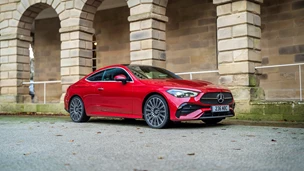Well, I didn’t get to drive the SW on the solo autotest in which it gave an excellent account of itself, but I certainly revelled in the looks of the smartest supermini-based estate on the market. The feline (as everybody keeps saying) front-end styling, the neat way the extended estate bodywork has been designed, the sleek roof rails, the glossy black B and C pillars, the Alfa 156-style "hidden" rear door handles, the 16" alloy wheels - all these features murmur (shout would be so gauche) "style".The SW leaves its few direct rivals well behind in the appearance stakes, and the interior is pretty snazzy too, with its mixture of leather, alcantara and attractive cloth trim. In the 2.0 Si, the sporty version with the 134bhp GTi engine, you also get aluminium pedals with not much room around them, an aluminium gearlever knob which is fine to the touch in mild weather, and an aluminium fuel filler cap which I managed to detach, and left, with an apologetic note, in a cubbyhole.Come on, now, some people are bound to ask, can a car this size, even with an extra 19mm of body length behind the rear wheels, really be an acceptable estate?Well, if there's one company that should know about estate car design, having turned out so many of them over the years, it's Peugeot. And yes, the SW is a sensibly presented if modestly scaled estate. The rear suspension units are tucked well out of the way, the wheel arches don't intrude, and there's a good load width plus a couple of net pockets, one on each side.The 60/40 split rear seats fold forward to create an unobstructed and almost dead-flat extension to the load area when required. Of course, in a car of this size you can hardly expect to get all that and generous rear-seat knee room, and the SW doesn't provide it. There are limits.Peugeot has given the SW a separately opening tailgate window, unusual in an estate of this size, and that's very handy when it comes to loading parcels and so on, without needing to open the whole tailgate. But it still seemed odd, as mentioned in our launch report of the Si, that the tailgate window has darkened glass. It's possible, in a quick glance through the rear-view mirror, not to notice a car right behind, at least in daylight when it wouldn't be showing any lights.The sports front seats in the SW are well designed and fully supportive. Peugeot has also made sure that the head rests, front and rear, are easily adjusted and, in the case of the ones on the rear seats, easily slid down out of the way of the view through the interior mirror.Out on the open road, the Si is a strong performer. There's 142lb/ft of torque at 4900rpm, and quite enough lower down to let the car romp up hills and make quick overtaking manoeuvres.The top price for the top model in the range brings ABS, EBD and brake assist, rain sensor wipers and light-sensitive headlamps whose sensitivity I kept wanting to be able to adjust. Going from no lights at all onto dipped headlamps when arriving under a filling station canopy seems a bit much, and I once got into the curious situation of having to put my visor down to avoid being blinded by the rays of a near-setting sun, at the same time as the dipped headlamps went on, having decided there wasn't enough light.It's possible in these circumstances to switch manually onto sidelights, but I didn't find an override control that would kill the dip.Other cars in the SW range - and I was surprised to note that there are so many of them, with 1.1-, 1.4- and 1.6-litre petrol engines, plus two sizes of turbo diesel, and three trim/equipment levels - offer a more supple ride, but there's no mistaking that Peugeot means the 2.0 Si to be the sports version. The suspension settings are decidedly firm, but that means, of course, that the Si can cope with the extra forces created by more vigorous cornering and a lot more power.The steering has speed-related power assistance, and, although some enthusiastic types claim to dislike that kind of system, I thought it worked well.While the 206 is the best-selling single model, of any make, on the European market, variants like the SW will always be in the minority, and the Si in a minority among the minority. But this is a top-rated car in a rather rarefied mini-sector of the market, and, although I might prefer one of the more softly suspended models for seven-day running, as a small sporting estate the Si is a peach.Second opinion: I remember thinking, during the press launch, that apart from a little extra body lean this car handled superbly. That was on the basis of quite a short drive. After more than week's experience I had forgotten all about body lean and decided that this was one of the most splendid-handling hot hatches I've tried in years. Yes, the ride is a bit skateboardy, but the cornering balance is excellent, and the strong mid-range pull of the engine adds to the country-road appeal. Negative points are the room in the rear and the not very adjustable driving position - I have to say that I never felt really comfortable behind the wheel. This is indeed a minority-interest vehicle, and I can't help wondering how many people actually want a hot mini-estate. But it's a lot of fun, and thanks to CARkeys future owners will be able to say that their car has a competition history, however humble. David Finlay. Engine 1997cc, 4 cylinders Power 134bhp Fuel/CO2 35.8mpg / 189g/km Acceleration 0-62mph: 9.3 seconds Top speed 130mph Price £14,680 Details correct at publication date

Our Rating



